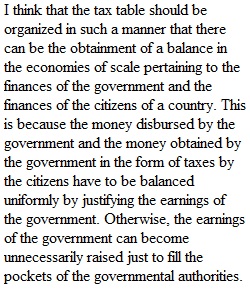


Q This week we're talking about tax brackets. See the breakdown in the document on the assignment page and share your thoughts. Files: 2016 tax brackets (.pdf, 54K) 54 kb document Here is part of the tax table for taxes due in 2016. Many people really do not understand how tax brackets operate, and you should. As a quick reminder, if you made 70k last year and were married filing jointly you would owe 10% on the first 18,450 (1845) + 15% on the next 51550 (7733) = 9578 This ends up being an effective rate of about 13.7% Each bracket applies just to that segment of your income. If you made 500,000 and were being taxed married filing jointly the 39.6% applies only to your last roughly 35,000. The highest tax rate has at times been over 90%. Regardless of what the top rate is, it never applies to all income, only to whatever portion of it falls into the top bracket. 2015 tax brackets (for taxes due April 15, 2016) Tax rate Single filers Married filing jointly or qualifying widow/ widower 10% Up to $9,225 Up to $18,450 15% $9,226 to $37,450 $18,451 to $74,900 25% $37,451 to $90,750 $74,901 to $151,200 28% $90,751 to $189,300 $151,201 to $230,450 33% $189,301 to $411,500 $230,451 to $411,500 35% $411,501 to $413,200 $411,501 to $464,850 39.6% $413,201 or more $464,851 or more If someone suddenly finds themselves in a higher tax bracket it NEVER means they are now taking home less than they would have been if they hadn’t made enough to get into that bracket. If you (still married, filing jointly) earn 230,450, you are paying X amount in taxes (it doesn’t matter what the exact amount is). If you earn 230,650 (so 200 more) you are paying X + 67 (33% of that 200). You are taking home 133 more than you were. You are NOT magically now having the entire amount taxed at 33% and taking home less money. There are a strange number of tips around tax time about how to avoid falling into a higher bracket. It’s fine to try to minimize taxes but switching brackets is really not that big a deal. So, now that we all know how taxes actually work, what should the tax table look like? What should the different tax rates be, and what amounts should they apply to? Or, if you want a flat tax, what should it be? What effect would that have on income inequality? Why is that the right move?
View Related Questions